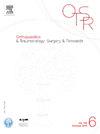First cuneo-metatarsal arthrodesis (Modified Lapidus) with plantar plate for the treatment of hallux valgus: clinical and radiological outcomes at one year follow-up
IF 2.3
3区 医学
Q2 ORTHOPEDICS
引用次数: 0
Abstract
Introduction
The modified Lapidus arthrodesis, involving the first cuneo-metatarsal joint, is a well-established surgical method and widely utilized for treating moderate to severe hallux valgus deformities with hypermobility in the first tarsometatarsal joint. The purpose of this study was to assess the rate of union following the Lapidus procedure using a plantar plate and an immediate full weight-bearing protocol. Secondary objectives included examining radiological corrections and potential associated complications.
Methods
A retrospective study included 66 patients (80 feet) who underwent a modified Lapidus procedure for the treatment of hallux valgus associated with hypermobility of the first ray, performed by a single senior surgeon at our institution between May 2013 and November 2019. All patients had a minimum follow-up of 12 months. Patients were clinically assessed at 3 weeks, 3 months, and 1 year. Radiological measurements were taken on weight-bearing dorsoplantar views preoperatively, at 3 months, and at 12 months postoperatively.
Results
Bone union was achieved in 79 cases (98.75%). There was one case of non-union, two wound complications (one infection and one dehiscence), two cases of symptomatic hardware requiring hardware removal, and one stress fracture associated with recurrence of hallux valgus that required revision. The mean hallux valgus angle (HVA) improved from 30.5 ° ±10.4 ° to 10.1 ° ±6.6 ° (p < .001), the mean intermetatarsal angle (IMA) improved from 13.4 ° ±3.6 ° to 5.6 ° ±2.9 (p < .001), The average sesamoid position improved from stage 5.9 ± 1.6 to stage 2.6 ± 1.2 (p < .001). The mean shortening of the first metatarsal was 3.6 mm ± 1.8. There was no significant difference between measurements at 3 and 12 months postoperatively.
Conclusion
Modified Lapidus with a planter plate and compression screw is a reliable method of fixation with a high union rate, permit an immediate protected weight bearing and a low complications rate.
Level of evidence
IV; Retrospective study
用足底钢板进行第一Cuneo-跖骨关节固定术(改良Lapidus)治疗拇指外翻:一年随访的临床和放射学结果。
简介:改良 Lapidus 关节内固定术涉及第一跖跗关节,是一种成熟的手术方法,广泛用于治疗第一跖跗关节过度活动的中重度拇指外翻畸形。本研究的目的是评估使用跖骨钢板和立即完全负重方案进行 Lapidus 手术后的结合率。次要目标包括检查放射学纠正和潜在的相关并发症:这项回顾性研究共纳入了66名患者(80只脚),他们在2013年5月至2019年11月期间接受了改良Lapidus手术,以治疗伴有第一跖骨活动度过高的拇指外翻。所有患者均接受了至少12个月的随访。患者分别在3周、3个月和1年时接受临床评估。术前、术后 3 个月和术后 12 个月在负重背跖切面上进行放射学测量:结果:79 例(98.75%)实现了骨结合。有一例骨不连,两例伤口并发症(一例感染,一例开裂),两例有症状的硬件需要移除,一例应力性骨折伴有拇指外翻复发,需要翻修。平均拇指外翻角度(HVA)从 30.5 ° ±10.4 ° 下降到 10.1 ° ±6.6 °(p 结论:拇指外翻角度从 30.5 ° ±10.4 ° 下降到 10.1 ° ±6.6 °:使用跖骨钢板和加压螺钉的改良 Lapidus 是一种可靠的固定方法,结合率高,可立即保护性负重,并发症发生率低:证据等级:IV;回顾性研究。
本文章由计算机程序翻译,如有差异,请以英文原文为准。
求助全文
约1分钟内获得全文
求助全文
来源期刊
CiteScore
5.10
自引率
26.10%
发文量
329
审稿时长
12.5 weeks
期刊介绍:
Orthopaedics & Traumatology: Surgery & Research (OTSR) publishes original scientific work in English related to all domains of orthopaedics. Original articles, Reviews, Technical notes and Concise follow-up of a former OTSR study are published in English in electronic form only and indexed in the main international databases.

 求助内容:
求助内容: 应助结果提醒方式:
应助结果提醒方式:


